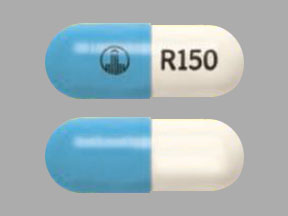Pradaxa Oral Pellets Dosage
Generic name: DABIGATRAN ETEXILATE MESYLATE 20mg
Dosage form: oral pellet
Drug class: Thrombin inhibitors
Medically reviewed by Drugs.com. Last updated on Jun 27, 2025.
Important Dosage Information
Dabigatran etexilate is available in different dosage forms and not all dosage forms are approved for the same indications and age groups. In addition, there are differences between the dosage forms with respect to dosing due to differences in bioavailability. Do not substitute different dosage forms (for example, capsules) for oral pellets on a milligram-to-milligram basis and do not combine more than one dosage form to achieve the total dose.
Recommended PRADAXA Oral Pellets Dosage for Pediatric Patients
PRADAXA Oral Pellets can be used in pediatric patients aged 3 months to less than 12 years as soon as they are able to swallow soft food. For the treatment of VTE in pediatric patients, treatment should be initiated following treatment with a parenteral anticoagulant for at least 5 days. For reduction in risk of recurrence of VTE, treatment should be initiated following previous treatment.
The recommended dosage of PRADAXA Oral Pellets is based on the patient's age and actual weight as shown in the tables below. PRADAXA Oral Pellets is administered twice daily. Adjust the dosage according to age and actual weight as treatment progresses.
| Actual Weight (kg) | Age (in months) | Dosage (mg) twice daily | Number of Packets Needed |
|---|---|---|---|
| 3 kg to less than 4 kg | 3 to less than 6 months | 30 mg | one 30 mg packet twice daily |
| 4 kg to less than 5 kg | 3 to less than 10 months | 40 mg | one 40 mg packet twice daily |
| 5 kg to less than 7 kg | 3 to less than 5 months | 40 mg | one 40 mg packet twice daily |
| 5 to less than 24 months | 50 mg | one 50 mg packet twice daily | |
| 7 kg to less than 9 kg | 3 to less than 4 months | 50 mg | one 50 mg packet twice daily |
| 4 to less than 9 months | 60 mg | two 30 mg packets twice daily | |
| 9 to less than 24 months | 70 mg | one 30 mg packet plus one 40 mg packet twice daily | |
| 9 kg to less than 11 kg | 5 to less than 6 months | 60 mg | two 30 mg packets twice daily |
| 6 to less than 11 months | 80 mg | two 40 mg packets twice daily | |
| 11 to less than 24 months | 90 mg | one 40 mg packet plus one 50 mg packet twice daily | |
| 11 kg to less than 13 kg | 8 to less than 18 months | 100 mg | two 50 mg packets twice daily |
| 18 to less than 24 months | 110 mg | one 110 mg packet twice daily | |
| 13 kg to less than 16 kg | 10 to less than 11 months | 100 mg | two 50 mg packets twice daily |
| 11 to less than 24 months | 140 mg | one 30 mg packet plus one 110 mg packet twice daily | |
| 16 kg to less than 21 kg | 12 to less than 24 months | 140 mg | one 30 mg packet plus one 110 mg packet twice daily |
| 21 kg to less than 26 kg | 18 to less than 24 months | 180 mg | one 30 mg packet plus one 150 mg packet twice daily |
| Actual Weight (kg) | Dosage (mg) twice daily | Number of Packets Needed |
|---|---|---|
| 7 kg to less than 9 kg | 70 mg | one 30 mg packet plus one 40 mg packet twice daily |
| 9 kg to less than 11 kg | 90 mg | one 40 mg packet plus one 50 mg packet twice daily |
| 11 kg to less than 13 kg | 110 mg | one 110 mg packet twice daily |
| 13 kg to less than 16 kg | 140 mg | one 30 mg packet plus one 110 mg packet twice daily |
| 16 kg to less than 21 kg | 170 mg | one 20 mg packet plus one 150 mg packet twice daily |
| 21 kg to less than 41 kg | 220 mg | two 110 mg packets twice daily |
| 41 kg or greater | 260 mg | one 110 mg packet plus one 150 mg packet twice daily |
Evaluation of the extent of anticoagulation in pediatric patients on PRADAXA Oral Pellets may be accomplished using dTT or ECT, and not INR.
Dosage Adjustments
Pediatric Patients with Renal Impairment
Assess renal function prior to initiation of treatment with PRADAXA Oral Pellets. Periodically assess renal function as clinically indicated (i.e., more frequently in clinical situations that may be associated with a decline in renal function) and adjust therapy accordingly. Discontinue PRADAXA Oral Pellets in patients who develop acute renal failure while on PRADAXA Oral Pellets and consider alternative anticoagulant therapy.
Prior to the initiation of treatment with PRADAXA Oral Pellets, estimate the glomerular filtration rate (eGFR) using the Schwartz formula, eGFR (Schwartz) = (0.413 × height in cm) / serum creatinine in mg/dL.
Due to lack of data in pediatric patients with an eGFR < 50 mL/min/1.73 m2 and the risk of increased exposure, avoid use of PRADAXA Oral Pellets in these patients. Treat patients with an eGFR > 50 mL/min/1.73 m2 with the dosage according to Tables 1 and 2.
Administration
PRADAXA Oral Pellets are administered twice daily, one dose in the morning and one dose in the evening, at approximately the same time every day. The dosing interval should be as close to 12 hours as possible.
If a dose of PRADAXA Oral Pellets is not taken at the scheduled time, the dose should be taken as soon as possible on the same day; the missed dose should be skipped if it cannot be taken at least 6 hours before the next scheduled dose. The dose of PRADAXA Oral Pellets should not be doubled to make up for a missed dose.
If a partial dose has been taken, a second dose should not be administered at that time. The next dose should be taken as scheduled approximately 12 hours later.
The prepared medication should be given before meals to ensure that the patient takes the full dose.
PRADAXA Oral Pellets should be administered immediately after mixing or within 30 minutes after mixing. If the PRADAXA dose is not administered within 30 minutes of mixing, the dose should be discarded, and a new dose prepared.
PRADAXA Oral Pellets should be administered with only specific soft foods or apple juice.
Administration with soft foods
PRADAXA Oral Pellets may be mixed with two teaspoons of the following soft foods at room temperature:
- Mashed carrots
- Apple sauce
- Mashed banana
Administration with apple juice
PRADAXA Oral Pellets may be spooned directly into the patient's mouth and swallowed with apple juice or added to approximately 1-2 ounces of apple juice for drinking.
PRADAXA Oral Pellets should not be administered:
- via syringes or feeding tubes
- with milk, milk products, or soft foods containing milk products
Instruct patients/caregivers to discard the desiccant once the package is opened.
See Instructions for Use.
Converting from or to Warfarin
When converting patients from warfarin therapy to PRADAXA Oral Pellets, discontinue warfarin and start PRADAXA Oral Pellets when the INR is below 2.0.
When converting from PRADAXA Oral Pellets to warfarin, adjust the starting time of warfarin as follows:
- For eGFR ≥ 50 mL/min/1.73 m2, start warfarin 3 days before discontinuing PRADAXA Oral Pellets.
- Patients with an eGFR < 50 mL/min/1.73 m2 have not been studied. Avoid use of PRADAXA Oral Pellets in these patients.
Because PRADAXA Oral Pellets can increase INR, the INR will better reflect warfarin's effect only after PRADAXA Oral Pellets have been stopped for at least 2 days.
Converting from or to Parenteral Anticoagulants
For pediatric patients currently receiving a parenteral anticoagulant, start PRADAXA Oral Pellets 0 to 2 hours before the time that the next dose of the parenteral drug was to have been administered or at the time of discontinuation of a continuously administered parenteral drug (e.g., intravenous unfractionated heparin).
For pediatric patients currently taking PRADAXA Oral Pellets, wait 12 hours after the last dose before switching to a parenteral anticoagulant.
Discontinuation for Surgery and Other Interventions
If possible, discontinue PRADAXA Oral Pellets before invasive or surgical procedures because of the increased risk of bleeding. For pediatric patients, PRADAXA Oral Pellets should be stopped 24 hours before an elective surgery (eGFR > 80 mL/min/1.73 m2) or 2 days before an elective surgery (eGFR 50-80 mL/min/1.73 m2). Pediatric patients with an eGFR < 50 mL/min/1.73 m2 have not been studied, avoid use of PRADAXA Oral Pellets in these patients.
Consider longer times for patients undergoing major surgery, spinal puncture, or placement of a spinal or epidural catheter or port, in whom complete hemostasis may be required.
If surgery cannot be delayed, there is an increased risk of bleeding. This risk of bleeding should be weighed against the urgency of intervention. In adults, a specific reversal agent (idarucizumab) is available in case of emergency surgery or urgent procedures when reversal of the anticoagulant effect of dabigatran is needed. Efficacy and safety of idarucizumab have not been established in pediatric patients. Refer to the idarucizumab prescribing information for additional information. Restart PRADAXA Oral Pellets as soon as medically appropriate.
Frequently asked questions
More about Pradaxa (dabigatran)
- Check interactions
- Compare alternatives
- Pricing & coupons
- Reviews (97)
- Drug images
- Side effects
- Dosage information
- During pregnancy
- Generic availability
- Support group
- FDA approval history
- Drug class: thrombin inhibitors
- Breastfeeding
- En español
Patient resources
Professional resources
Related treatment guides
See also:
Further information
Always consult your healthcare provider to ensure the information displayed on this page applies to your personal circumstances.


